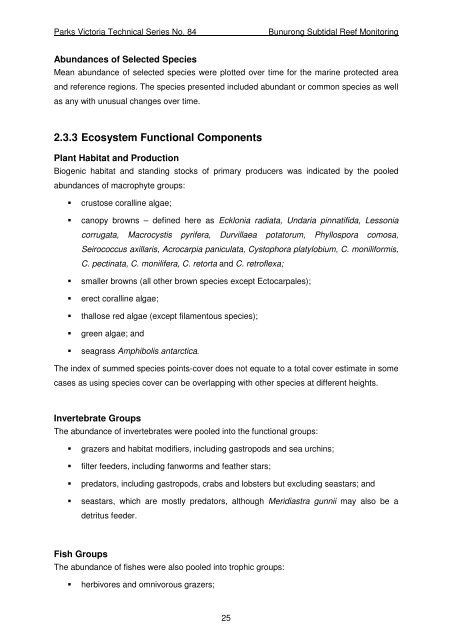the reef biota at bunurong marine national park - Parks Victoria
the reef biota at bunurong marine national park - Parks Victoria
the reef biota at bunurong marine national park - Parks Victoria
You also want an ePaper? Increase the reach of your titles
YUMPU automatically turns print PDFs into web optimized ePapers that Google loves.
<strong>Parks</strong> <strong>Victoria</strong> Technical Series No. 84<br />
Bunurong Subtidal Reef Monitoring<br />
Abundances of Selected Species<br />
Mean abundance of selected species were plotted over time for <strong>the</strong> <strong>marine</strong> protected area<br />
and reference regions. The species presented included abundant or common species as well<br />
as any with unusual changes over time.<br />
2.3.3 Ecosystem Functional Components<br />
Plant Habit<strong>at</strong> and Production<br />
Biogenic habit<strong>at</strong> and standing stocks of primary producers was indic<strong>at</strong>ed by <strong>the</strong> pooled<br />
abundances of macrophyte groups:<br />
<br />
<br />
<br />
<br />
<br />
<br />
<br />
crustose coralline algae;<br />
canopy browns – defined here as Ecklonia radi<strong>at</strong>a, Undaria pinn<strong>at</strong>ifida, Lessonia<br />
corrug<strong>at</strong>a, Macrocystis pyrifera, Durvillaea pot<strong>at</strong>orum, Phyllospora comosa,<br />
Seirococcus axillaris, Acrocarpia panicul<strong>at</strong>a, Cystophora pl<strong>at</strong>ylobium, C. moniliformis,<br />
C. pectin<strong>at</strong>a, C. monilifera, C. retorta and C. retroflexa;<br />
smaller browns (all o<strong>the</strong>r brown species except Ectocarpales);<br />
erect coralline algae;<br />
thallose red algae (except filamentous species);<br />
green algae; and<br />
seagrass Amphibolis antarctica.<br />
The index of summed species points-cover does not equ<strong>at</strong>e to a total cover estim<strong>at</strong>e in some<br />
cases as using species cover can be overlapping with o<strong>the</strong>r species <strong>at</strong> different heights.<br />
Invertebr<strong>at</strong>e Groups<br />
The abundance of invertebr<strong>at</strong>es were pooled into <strong>the</strong> functional groups:<br />
<br />
<br />
<br />
<br />
grazers and habit<strong>at</strong> modifiers, including gastropods and sea urchins;<br />
filter feeders, including fanworms and fea<strong>the</strong>r stars;<br />
pred<strong>at</strong>ors, including gastropods, crabs and lobsters but excluding seastars; and<br />
seastars, which are mostly pred<strong>at</strong>ors, although Meridiastra gunnii may also be a<br />
detritus feeder.<br />
Fish Groups<br />
The abundance of fishes were also pooled into trophic groups:<br />
<br />
herbivores and omnivorous grazers;<br />
25

















